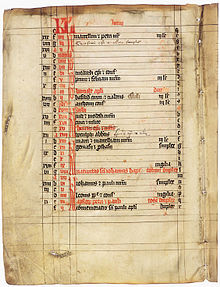Church calendar

Two time-counting systems were used in the medieval Christian calendar: solar and lunar. Christians adopted the sunny Julian calendar, introducing a 7-day week borrowed from the Jews. The use of the lunar count in the church calendar found expression in the manner in which the Passover was determined, that is Easter, celebrated in the Christian Church since the 2nd century. This holiday was dependent on the spring full moon, therefore it has become a movable feast. It was established, that Easter should fall on the first Sunday after the first spring full moon on the day before 21 III. According to this rule, Easter falls from 22 III do 25 IV, so in the period 35 days.
The church calendar used in church life divides the year into 2 periods: Christmas period (lasting from the first Sunday of Advent to the Saturday before the Orthodox Sunday, i.e. the so-called. the seventieth) and the period of Easter (lasting from the Orthodox Sunday to the Saturday before the first Advent Sunday). Christmas - unlike Easter - is permanent (it always falls on the day 25 XII). The ecclesiastical year marked by Easter is therefore also internally movable. The Easter period already starts on 70 days before Easter. These days - it's the time of the so-called. Preparations, starting with the ancient sunday, without a fixed date, just like Ash Wednesday, from which the so-called. Lent, ongoing 40 days. Mobile Easter, therefore, shortens or lengthens the time after Christmas, always starting 14 And it lasted until the seventeen. Thus, the post-holiday period of Easter is shortened or lengthened: it lasts for 23-28 weeks - until the first Sunday of Advent (4 Advent Sunday are constant, they are designated by the feast of Christmas). It's not calendar straight. However, it coincides with the Gregorian calendar in the length of the year. It designates only the religious life of the Church and its faithful.